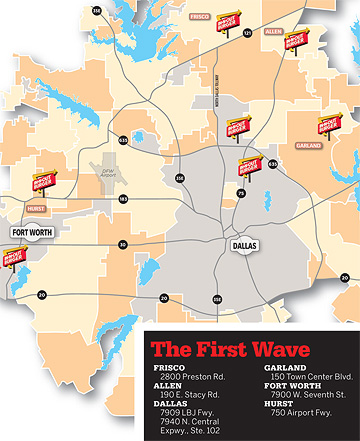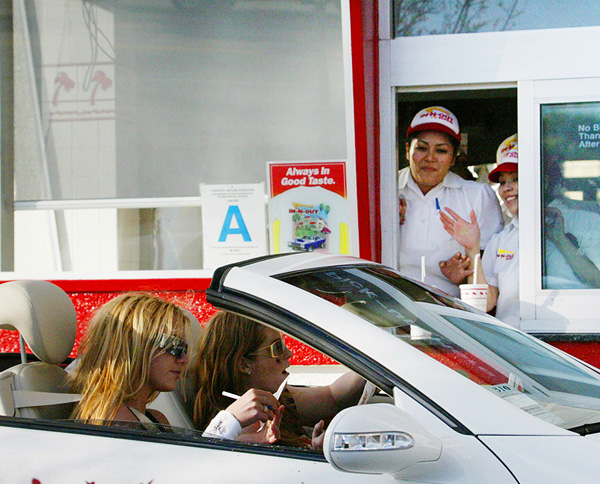
The perks come with high expectations. Workers are required to learn the company’s history. Managers take training classes at In-N-Out University, where they are constantly reminded of the company’s core values.
Beneath its squeaky-clean public persona, though, In-N-Out has a star-crossed family history that resembles a Hollywood soap opera. When Harry Snyder died in 1976, he left the 18-store chain in the hands of his 24-year-old son, Rich. The younger of two brothers, Rich was tasked with keeping his father’s legacy intact while adapting the fledgling chain to changing times.
Under Rich’s reign, In-N-Out raised its profile from a humble local burger stand to a regional Southern California fast-food chain. Deeply religious, Rich began printing Bible verses on burger packaging, and he aired pro-Christian In-N-Out radio ads. The move could have stunted the chain’s growing popularity. Instead, people who like the hamburgers just took the religiosity as another manifestation of the company’s eccentricity.
Rich grew the company throughout the 1980s, eventually taking the company to 93 stores and expanding to Las Vegas. He hired a team of top-notch industry executives and made plans to relocate the firm’s corporate headquarters closer to his mansion on the coast.
He never lived to see the new offices. In 1993, Rich and two other company executives were killed in a private jet crash. The tragedy left the institution in the hands of Rich’s unwilling older brother.
H. Guy Snyder had a penchant for fast cars and fast living. He suffered from depression and drug addiction throughout his adult life, according to Stacy Perman’s 2009 unauthorized history of the company, In-N-Out Burger: a Behind-the-Counter Look at the Fast-Food Chain That Breaks All the Rules. Having been passed over for the top job after his father’s death, Guy had little to do with In-N-Out’s operations until Rich died. “I think there was fear that as the rogue brother, he would turn things upside down,” a Snyder friend told a local newspaper at the time.
Thanks to the strong executive infrastructure created by Rich, In-N-Out plugged along, growing to 140 locations under Guy’s tenure. In 1999, six years after his brother’s death, Guy died of an accidental drug overdose. The deaths of the Snyder sons made Guy’s 17-year-old daughter, Lynsi, the soul family heir. And it left the ailing 79-year-old Esther Snyder, who had now outlived the three men in her life, as the keeper of the In-N-Out flame.
As stores stretched beyond the chain’s core Southern California footprint, the spotlight once again fell on In-N-Out’s inner world in 2006. This time, things got ugly. A longtime executive and Snyder family friend sued the company for allegedly going into hyperexpansion mode. At first blush, the accusation seemed preposterous. For any other chain, expansion would be a sign of prosperity. But not at In-N-Out. The Snyder family believed in measured growth, expanding at a steady rate of 10 to 12 stores annually for fear of losing quality control. The lawsuit accused the then 23-year-old Lynsi, heir to a fortune valued at $450 million, of leading a coup to steal the chain from her grandmother, an allegation she strenuously denied.
The bitter family feud catapulted the chain into the national media, where headlines trumpeted the court case as a generational battle between the past and the future. The case was settled before Esther was forced to testify, and she died a few months later. In-N-Out burgers were served at her funeral. Not long after, Lynsi gave birth to twins, the next in line to inherit the In-N-Out empire. With Mark Taylor (related to the Snyders by marriage) at the helm since 2006, the chain has opened 50 more restaurants.
Quirky corporate culture aside, In-N-Out wouldn’t have the following it does if the chain didn’t serve something worth raving about. But ask a dozen fans to pinpoint their fascination with In-N-Out, and a lively debate will likely ensue. Because at the heart of this burger love story, is this: In-N-Out means different things to different people.
David Montero, my friend since college, is a self-described In-N-Out piner, deprived of the burger when he moved to Denver a few years ago. While living in Colorado, he found himself reminiscing with fellow California transplants about the burger’s allure. “We’d talk about the buns, slightly toasted, that offered a soothing crunch with the first bite, coupled with the taste of the cold lettuce and a mouthful of that glorious sauce,” Montero says. “Had they been able, my taste buds would’ve hatched an escape plan and taken the first trip to California for a Double-Double fix.”
Loyalists have been known to drive hundreds of miles, even jump on planes, to satisfy an In-N-Out urge. Unpaid endorsements also come from a bevy of rock stars, celebrity chefs, and Hollywood elite. Bob Hope, Dinah Shore, and Eddie Fisher noshed on In-N-Out on the way to and from wintering in Palm Springs back in the 1950s. Julia Child once sent her assistant out for In-N-Out during a hospital stay. French Laundry chef Thomas Keller served Double-Doubles at the Napa restaurant’s anniversary party. Tom Hanks had the burgers delivered to cast and crew on the set of The Green Mile. Paris Hilton famously claimed she was on her way to In-N-Out when she was pulled over for a DUI. And Anthony Bourdain once told me his favorite fast-food meal is—wait for it—In-N-Out’s Animal Style burger.
It’s the kind of loyalty that Burger King and McDonald’s will never have. While most fast-food chains live and die by limited-time menu creations, discounting, and coupons, In-N-Out never resorts to those gimmicks. Other than combo meals, the most expensive single item sold on the menu is $3.05. It sells burgers, fries, sodas, and shakes. Nothing else. No onion rings. No salads. No chicken sandwiches. Not even a hot dog. The most recent change to the menu, made a decade ago, was the addition of lemonade.
The Double-Double (two patties, two slices of American cheese) remains the chain’s most popular item. But it’s rare to find any two customers who order the same meal. That’s because In-N-Out offers a limited menu with unlimited options. Made-to-order burgers, even bloody ones as I mentioned earlier, are the soul of In-N-Out’s allure. Varied burger concoctions requested over the years eventually led to the birth of a secret menu—which the chain denies exists (see sidebar, page 58). Burgers with names such as Animal Style, Protein Style, Flying Dutchman, 3×3, and 4×4 are celebrated underground requests never seen on the menu.
You can order a burger grilled with mustard. Get your onions chopped or ringed—raw or grilled. Asking for “light onion” means cooks will toss a few onion circles on the burger. If you like the secret sauce, ask for extra “spread” packets (kept in a refrigerator under the counter). If you want a triple cheeseburger (3×3) or a quad (4×4), just ask. For crispier fries, order them well done.
In 2004, a group of eight San Francisco friends ordered a 100×100 burger as a lark. After they polished off the 100 patties and 100 slices of cheese squeezed between a pair of buns—and documented the feat in a blog post that went viral—In-N-Out promptly banned the beast from the menu, secret or otherwise.
“The largest burger we will make now is a 4×4,” Van Fleet says. “Anything bigger than that takes way too much time and causes other customers to endure too long of a wait.”
The chain’s most famous custom order, the Animal Style burger, has murky origins. A former veteran In-N-Out manager who knew the Snyders once told me that the burger (made with mustard cooked into the beef, extra spread, and grilled chopped onions) was a favorite among a gang of unsavory customers at the original Baldwin Park restaurant. The impeccably groomed and clean-cut In-N-Out cooks, referring to their unruly guests, wound up calling the special order Animal Style.
No doubt it will take awhile for the full In-N-Out burger lexicon to spread across Dallas. But you Texans have already demonstrated an eagerness to learn the lingo. In 2000, In-N-Out sued Texas-based Whataburger for selling a Double-Double, which, even though it is a “secret” menu item, In-N-Out has trademarked. In that little skirmish, as I suspect will happen in its latest offensive, In-N-Out emerged victorious.
Nancy Luna is a restaurant writer for the Orange County Register in Santa Ana, California, where she runs a blog called The Fast Food Maven.






